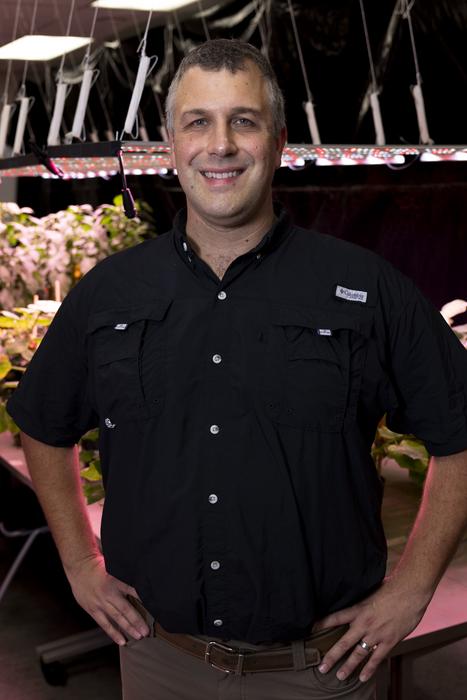FAYETTEVILLE, Ark. — Ryan Dickson, an assistant professor of horticulture for the Arkansas Agricultural Experiment Station, has been developing research since 2018 on growing blackberries indoors and recently secured a nearly $750,000 grant to further that work over the next four years.

Credit: U of A System Division of Agriculture photo by Paden Johnson
FAYETTEVILLE, Ark. — Ryan Dickson, an assistant professor of horticulture for the Arkansas Agricultural Experiment Station, has been developing research since 2018 on growing blackberries indoors and recently secured a nearly $750,000 grant to further that work over the next four years.
The experiment station is the research arm of the University of Arkansas System Division of Agriculture and is home to the largest public-sector breeding program for fresh-market blackberries in the United States. The grant comes from the U.S. Department of Agriculture’s National Institute of Food and Agriculture and is part of the Foundational Knowledge of Agricultural Production Systems program within the Agriculture and Food Research Initiative.
“Consumer demand is increasing for fresh-market blackberries, so this work promotes the ability of U.S. blackberry producers to meet domestic demands long-term,” said Dickson, whose research focus is on greenhouse and controlled environment agriculture.
According to the Packer’s Fresh Trends 2024 survey, 33.2 percent of consumers said they purchased fresh blackberries in the past year, compared with past survey results of 25 percent in 2023, 26 percent in 2022 and 28 percent in 2021.
The main issues blackberry growers are facing, Dickson said, include declining yield caused by soilborne pathogens and climate variability, and rising production costs that erode profit margins. Breeding for disease resistance is an option, he noted, but is time-consuming and shouldn’t be relied on solely because it does not solve all the issues farmers are facing.
Dickson’s research aims to develop innovative soilless long-cane production techniques to increase yields, improve fruit quality and enhance the profitability and sustainability of blackberry farming.
“The future sustainability of blackberry production and improved food security requires development of new knowledge and innovative approaches to increase yields,” Dickson said. “It also requires outreach efforts targeting a broad fruit grower audience spanning across food systems.”
Making it an integrated research and extension project, Dickson will work with Amanda McWhirt, extension fruit and vegetable horticulture specialist and associate professor for the Division of Agriculture, to evaluate novel soilless long-cane production techniques. The Arkansas Cooperative Extension Service is the public outreach side of the Division of Agriculture.
Long-cane method
Dickson’s research calls for growing blackberries in soilless substrate containers using the long-cane system. The blackberries are first grown outdoors in containers and trimmed to form long canes for easier management indoors.
Dickson has been testing Arkansas-bred floricane varieties that typically need two seasons to produce fruit. The idea, he said, is to essentially trick plants into feeling like they have gone through a wintertime by keeping them in a walk-in cooler. After this artificial winter, the plants could theoretically be transferred to a warm high tunnel or greenhouse, ready to produce fruit on demand, out of season.
Strawberries, blueberries and raspberries have been grown in substrates for years like this, but not blackberries.
Dickson said the main goals and potential benefits of long-cane blackberry production are increased yields, better fruit quality and consistency, and out-of-season production.
Moving the blackberry industry forward
The project has four main objectives:
- Cultivar selection and cultural practices — Researchers will evaluate how different blackberry cultivars and targeted cultural practices influence long-cane yield and fruit quality.
- Economic analysis — The project will include breakeven and risk analyses for both long-cane and field-based blackberry systems, identifying key profitability drivers.
- Outreach — Rapid and long-term application of research results will be targeted at both small and large operations to ensure wide adoption of successful practices.
- Soilless systems — The research will explore how soilless systems can reduce losses from disease and increase yields, ultimately benefiting local and regional economies.
Experiments will be conducted in high tunnels at the Milo J. Shult Agricultural Research and Extension Center in Fayetteville and the Fruit Research Station in Clarksville. The tunnels will be equipped with advanced systems for irrigation and “fertigation,” in which dissolved fertilizers are delivered through irrigation, and plants will be grown in coconut coir substrate. The research will involve collaboration with industry sponsors and the Division of Agriculture’s fruit breeding program.
To learn more about Division of Agriculture research, visit the Arkansas Agricultural Experiment Station website: https://aaes.uada.edu. Follow on Twitter at @ArkAgResearch. To learn more about the Division of Agriculture, visit https://uada.edu/. Follow us on Twitter at @AgInArk. To learn about extension programs in Arkansas, contact your local Cooperative Extension Service agent or visit www.uaex.uada.edu.
About the Division of Agriculture
The University of Arkansas System Division of Agriculture’s mission is to strengthen agriculture, communities, and families by connecting trusted research to the adoption of best practices. Through the Agricultural Experiment Station and the Cooperative Extension Service, the Division of Agriculture conducts research and extension work within the nation’s historic land grant education system.
The Division of Agriculture is one of 20 entities within the University of Arkansas System. It has offices in all 75 counties in Arkansas and faculty on five system campuses.
The University of Arkansas System Division of Agriculture offers all its Extension and Research programs and services without regard to race, color, sex, gender identity, sexual orientation, national origin, religion, age, disability, marital or veteran status, genetic information, or any other legally protected status, and is an Affirmative Action/Equal Opportunity Employer.



